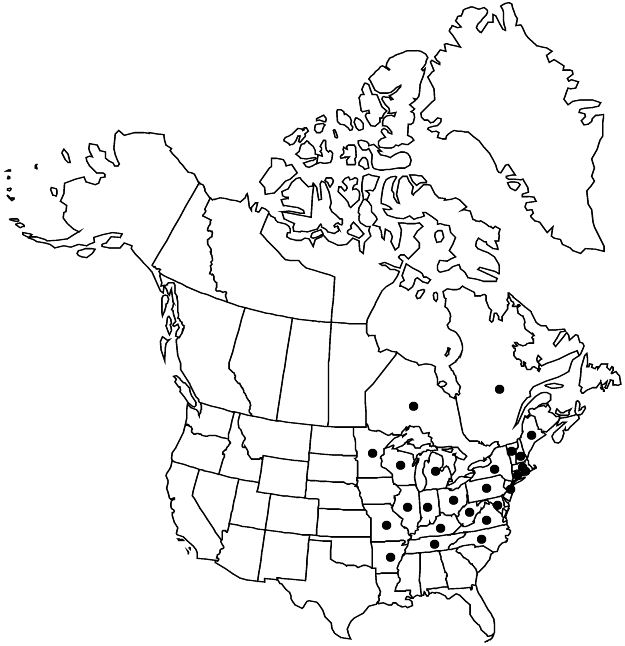Crataegus schuettei
J. Elisha Mitchell Sci. Soc. 17: 7. 1901.
Shrubs or trees, 40–70 dm. Stems: twigs: new growth reddish, glabrous, 1-year old shiny reddish brown, older dull gray; thorns on twigs 1-year old glossy, dark brown to blackish, ± stout, 3–6 cm. Leaves: petiole length 50–60% blade, usually glandular; blade ovate to oblong-ovate or narrowly ovate (ovate on extension shoots), 3–6 cm, base truncate, rounded, or cuneate, lobes 4 or 5 per side, sinuses moderately deep, lobe apex acute to acuminate, margins serrate, teeth 1 mm, veins 5 or 6 per side, apex acute, adaxial surface sparsely to densely scabrous-pubescent young, early glabrescent. Inflorescences 4–10-flowered; branches usually glabrous, rarely sparsely pubescent; bracteoles absent or few, linear. Flowers 15–26 mm diam.; hypanthium glabrous; sepals 3–4 mm, margins subentire or glandular-serrate, abaxially glabrous; stamens 20, anthers red; styles 3–5. Pomes red, ellipsoid to suborbicular, 8–20 mm diam., succulent; sepals ± erose or erect-patent; pyrenes 3–5, dorsally grooved. 2n = 51.
Distribution

Ont., Que., Ark., Conn., Ill., Ind., Ky., Maine, Mass., Md., Mich., Minn., Mo., N.C., N.H., N.J., N.Y., Ohio, Pa., R.I., Tenn., Va., Vt., W.Va., Wis.
Discussion
Varieties 4 (4 in the flora).
Crataegus schuettei ranges from Wisconsin through the southern Great Lakes to southern New England, to North Carolina. Recent discoveries add the Ozarks and may add Minnesota (see discussion under C. fluviatilis) to the documented range. Variety schuettei closely resembles C. macrosperma, differing principally in its often larger flowers, 20 stamens, usually glandular-serrate sepal margins, and larger fruit but is not nearly so variable as C. macrosperma; the other varieties are very rare. Still, the four varieties are fairly distinct. Crataegus basilica appears to be the southern form of the type variety and is very like sympatric C. macrosperma except for stamen number.
Selected References
None.
Lower Taxa
Key
| 1 | Inflorescence branches sparsely pubescent; leaf blades narrowly ovate, bases ± narrowly cuneate. | Crataegus schuettei var. cuneata |
| 1 | Inflorescence branches glabrous; leaf blades ± ovate to ovate-oblong, bases subtruncate or broadly cuneate to rounded | > 2 |
| 2 | Flowers 24–26 mm diam.; pomes 15–20 mm diam. | Crataegus schuettei var. gigantea |
| 2 | Flowers 15–20 mm diam.; pomes 8–15 mm diam | > 3 |
| 3 | Leaf blades ± ovate, sinuses shallow (max LII 15–20%), proximal lobes almost never most deeply separated, spreading at 45º–60º. | Crataegus schuettei var. schuettei |
| 3 | Leaf blades ovate to ovate-oblong, proximal sinuses deep (max LII 30–40%), proximal lobes the most deeply separated, spreading at 60º–80º. | Crataegus schuettei var. ferrissii |